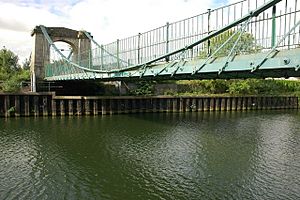Victoria Bridge, Bath facts for kids
Quick facts for kids Victoria Bridge |
|
|---|---|
 |
|
| Coordinates | 51°23′00″N 2°22′24″W / 51.3834°N 2.3733°W |
| Crosses | River Avon |
| Locale | Bath, England |
| Owner | Bath and North East Somerset Council |
| Heritage status | Grade II* listed building |
| Preceded by | Midland Bridge |
| Followed by | Destructer Bridge |
| Characteristics | |
| Design | cable-stayed double cantilever suspension bridge |
| Material | Bath stone and iron |
| Total length | 45.7 m (150 ft) |
| Width | 5.8 m (19 ft) |
| Number of spans | 1 |
| History | |
| Architect | James Dredge, Sr. |
| Engineering design by | Motley and Dredge |
| Construction begin | August 1836 |
| Construction end | December 1836 |
The Victoria Bridge is a historic bridge in Bath, England. It was built in 1836 and crosses the River Avon. This bridge is special because it is a Grade II* listed building. This means it is a very important historical structure that needs to be protected.
The Victoria Bridge is a great example of a suspension bridge. When it was first built, it was used by horses and carts. Later, it became a path for people walking and riding bicycles.
Contents
Building the Victoria Bridge: A Unique Design
The Victoria Bridge is a special kind of bridge called a "Dredge taper bridge." It was built by Motley and Dredge. People today often see it as a mix between a suspension bridge and a cable-stayed bridge.
How the Bridge Was Designed
The bridge stretches 45.7 meters (150 feet) across the river. Its main chains hang from strong towers made of Bath stone. This is a type of limestone found in the Bath area. The road part of the bridge is connected to these chains by iron bars. These bars are unusual because they are not straight up and down.
Why James Dredge Built It
James Dredge, who was a brewer in Bath, designed this bridge. He wanted a way to get beer from his brewery across the river. This bridge meant he didn't need to use a ferry or go all the way through the city center. Building the bridge cost £1,760.
Dredge created a special design called the 'taper principle'. This design used chains instead of the cables that are more common in suspension bridges today. His bridge design was seen as a very important step in how suspension bridges developed, even though it was only used for a short time.
Bridge Materials and Use
The main chains of the Victoria Bridge have 155 links. Each link is 2.5 meters (8.2 feet) long. They support two hangers made of wrought iron. The bridge deck, where people walk or ride, is made of wooden planks.
At first, the bridge was strong enough for horse-drawn carts. Over time, it was only used by people on foot and bicycles.
Bridge Closures and Restoration Work
In October 2010, the Victoria Bridge had to be closed. This happened because people were worried about how safe its beams and cables were. Cyclists in Bath were not happy about this closure. The bridge reopened briefly in October 2010, but then it closed again.
Inspections and Further Closures
More checks were done by a structural engineer in September 2011. In November 2011, the path next to the river (called the tow-path) was closed. After that, boats were not allowed to use the river under the bridge either. The bridge was even put on the Heritage at Risk Register. This list includes important historical places that are in danger.
Repairing the Bridge
In 2011, it was thought that repairing the bridge would cost about £3 million. Emergency work was done in November 2011 to support both sides of the bridge and add temporary straps. The full repair work was first planned to be finished by the winter of 2013.
Work to restore the bridge finally began in 2014. A new inside structure was put in place. This allowed the bridge and the canal below to be used while repairs were happening. The bridge was carefully taken apart and then put back together. It was made stronger with extra steel and painted a dark green color. The Victoria Bridge officially reopened on January 15, 2015.


